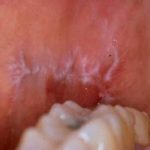
Lichen planus is a chronic inflammatory auto-immune disorder which can affect the skin (including scalp), oral mucosa, genitalia, nails and oesophagus (Dental Elf – 22nd Nov 2017). It’s prevalence ranges between 0.5-1% with a female sex predisposition of 1.3:1 (female:male). Over 60% of cases occur between 30-60 years of age. Pharmacological management involves the use of corticosteroids, retinoids, photodynamic therapy, calcineurin inhibitors, vitamin D and hyaluronic acid whilst non-pharmacological measures include maintaining good oral hygiene, smoking cessation and avoidance of appliances causing trauma.
The aim of this systematic review and network meta-analysis was to compare the interventions evaluated in clinical trials for the management of oral lichen planus.
Methods
The Preferred Reporting Items for Systematic Review and Meta-Analyses (PRISMA) were used to inform the methodology of this systematic review and meta-analysis. Only randomised control trials carried out in symptomatic patients diagnosed with oral lichen planus of any subtype following histopathology without systemic involvement. The Cochrane risk of bias tool was used to assess the quality of studies. The evidence was graded using the Grades of Recommendation, Assessment, Development and Evaluation (GRADE) working group approach.
Results
Results are selectively reported compared to placebo alone.
- 55 studies were included in this systematic review and meta-analysis comprising 2831 patients. 3 studies did not report their outcomes amenable for pooled estimate calculations hence were omitted from the meta-analysis.
- Clinical resolution (23 studies; 852 patients pooled) –Compared with placebo there were significantly greater proportions of patients with clinical resolution for: –
- purslane (OR: 18.4; 95% CI 3.5, 97.1),
- cyclosporine (OR: 289; 95% CI: 5.1, 16317),
- pimecrolimus (OR: 21; 95% CI 1.8-248.1).
- Clinical scores (28 studies; 1205 studies) – There were significantly lower clinical scores for hyaluronic acid (WMD: -0.5; 95% CI: -0.7, -0.3) compared to placebo.
- Pain resolution (13 studies; 568 patients) – Compared with placebo significantly higher pain resolution was seen for: –
- corticosteroids (OR: 3.18; 95% CI: 1.2, 8.43),
- ozonized water/corticosteroids (OR: 9.9; 95% CI: 2.7, 36.2),
- aloe vera (OR: 13; 95% CI: 1.5, 111.8),
- pimecrolimus (OR: 18.8; 95% CI: 1.3, 457.6),
- hyaluronic acid (OR: 24.8; 95% CI: 1.2, 16.3).
- Pain scores (27 studies; 1137 patients) – compared to placebo. There were significantly lower pain scores with:-
- corticosteroids (WMD: -1.8; 95% -3.5, -0.1),
- cyclosporine (WMD: -1.2; 95% CI: -1.4, -1),
- hyaluronic acid (WMD: -6.3; 95% CI: -7.1, -5.5),
- MuGard (WMD: -3.5; 95% CI: -5.6, -1.4).
- Adverse effects (14 studies; 618 patients) – Pimecrolimus (OR: 9.6; 95% CI 1.2, 75.4) and cyclosporine (OR: 18.8; 95% CI: 1.1, 313.6) were associated with significantly higher risks of adverse effects compared to placebo.
- The quality of evidence was graded between very low to low.
Conclusions
The authors concluded:
…we identified topical corticosteroids… to be the most effective drug class for treating oral lichen planus.
Comments
A recent Cochrane systematic review evaluating the treatment of oral lichen planus (Dental Elf – 4th March 2020) which concluded corticosteroids, delivered topically or as adhesive gels (or similar preparations) may be more effective than placebo for reducing the pain of symptomatic OLP nonetheless, the small number of studies means the confidence in reliability of this finding is low. The reported systematic review and network meta-analysis highlighted several treatment modalities that were significant in improving patient outcomes however graded the quality of evidence as very low to low. Similarly to the Cochrane systematic review, the included studies are of limited quality and therefore there are limited conclusions which can be drawn from this. The literature would benefit from higher quality and well reported randomised control trials to evaluate the effectiveness of treatment modalities for oral lichen planus.
References
Primary reference
Sridharan K, Sivaramakrishnan G. Interventions for oral lichen planus: A systematic review and network meta-analysis of randomized clinical trials. Aust Dent J. 2021 Mar 8. doi: 10.1111/adj.12835.
Other references
Dental Elf – 22nd Nov 2017
Dental Elf – 4th Mar 2020
Oral Lichen Planus: Is treatment with corticosteroids safe and effective?
Picture Credits
By James, Candice, Mai – http://bohone09.wikispaces.com/Group+1, CC BY-SA 3.0,
